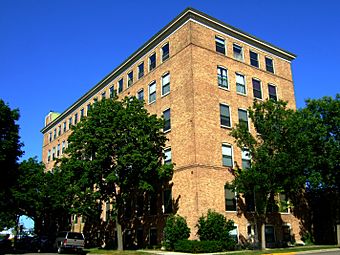Badger State Shoe Company building facts for kids
Quick facts for kids |
|
|
Badger State Shoe Company
|
|
 |
|
| Location | 123 N. Blount St. Madison, Wisconsin |
|---|---|
| Built | 1910 |
| Architect | Ferdinand Kronenberg |
| Architectural style | Classical Revival |
| NRHP reference No. | 89000232 |
| Added to NRHP | April 11, 1989 |
The Badger State Shoe Company building is an old, six-story factory in Madison, Wisconsin. It was built in 1910 and used to make shoes. This special building was added to the National Register of Historic Places on April 11, 1989, because of its history and unique style. It stands about half a mile northeast of the Capitol building.
Contents
History of the Shoe Factory
Madison's Early Growth
Madison was chosen to be Wisconsin's capital city. From the beginning, it had more "white-collar" jobs. These are jobs like office work, government, and university roles. Other cities nearby often grew with factories and mills. After the American Civil War, Madison had only a few mills and an iron factory. Some leaders wanted Madison to attract bigger industries. But others, especially government and university workers, worried about pollution.
Growth was slow in the late 1800s due to an economic slump. Still, some factories like Carmin & Billings Plow Works started up. After 1900, more industries began to grow in Madison. The Badger State Shoe Company was one of these new businesses.
How Shoes Were Made
In the 1800s, shoemaking changed a lot. It went from small local shops to large factories. These factories used machines and many workers to make shoes quickly. Cities near Lake Michigan had big leather tanneries. This meant they had plenty of leather. Good transportation also helped shoe production grow in these areas.
The Badger Shoe Company first started in Milwaukee in 1893. They had been a different shoe company before that. The main people in charge were Albert and Henry L. Atkins. In 1900, they moved their factory from Milwaukee to South Madison. They might have done this to save money on their operations. After a few years, they opened another factory on Wilson Street. In 1909, they decided to bring all their operations into one new building.
Choosing a Location
The company chose a spot on Blount Street for their new factory. This area was once a low-lying marsh. In the 1890s, people started filling in and developing this land. Many streets there were built using cinder-fill. The area mixed factories with homes. Train tracks were just a few blocks south. This made it easy to transport materials and finished shoes.
Designing the Building
Badger Shoe hired Ferdinand Kronenberg to design their new factory. Kronenberg was born in Germany around 1877. He learned his trade in Madison. He had designed homes and the Cardinal Hotel in Madison. For the shoe factory, he designed a six-story building. It was covered in Chicago brick.
The factory's design was simple but elegant. It had many windows placed evenly. The corners of the building had solid brick from top to bottom. This made them look like strong columns. Lines of brick below the third and sixth-floor windows added to its classic look. The very top of the building had a decorative iron trim. This also looked like something from classical architecture.
Inside the Factory
Inside, the building had a wooden frame. Large wooden posts supported thick wooden beams. These beams held up two-inch pine planks, which were covered with maple flooring. The main office entrance was at the front. It led up a short flight of stairs to offices on the second floor. Most of the building was used for making shoes.
The factory was very modern for its time. It had lots of natural light from the many windows. It was also well-ventilated, meaning fresh air could move through easily. It even had an automatic sprinkler system for safety.
Factory Operations and Changes
The building cost $40,000 to build. The factory started making shoes in the spring of 1910. About 250 people worked there. Soon, they were making 2,000 pairs of women's and children's shoes every day. These shoes were sold to a large company in Chicago.
Sales grew a lot during World War I. In 1917, Edward C. Wolfram bought the factory. He was a businessman from Watertown, Wisconsin.
In the 1920s, shoe materials began to change. People started using more synthetic materials instead of just leather. Also, more shoes were being imported from other countries. Making shoes became less profitable. After the Great Depression started, Badger Shoe stopped making shoes in 1930. All of the Wolfram family's businesses were sold off.
Later Uses and Restoration
After the shoe factory closed, Crescent Electric bought the building. They used it as a warehouse. Later, Rowley-Schlimgen, an office supply company, bought it. At some point, many of the windows were covered with bricks. Old photos show this change.
In 1989, the building was added to the National Register of Historic Places. It was special because it was one of the few mid-sized factories from that time left in Madison. Its classic style was also unusual for a factory. The Madison Landmarks Commission also named it a landmark in 1989.
In recent years, a company called Alexander Companies restored the building. They uncovered the windows and turned the factory into apartments. These apartments are now called Das Kronenberg Apartments.

